Your cart is currently empty.
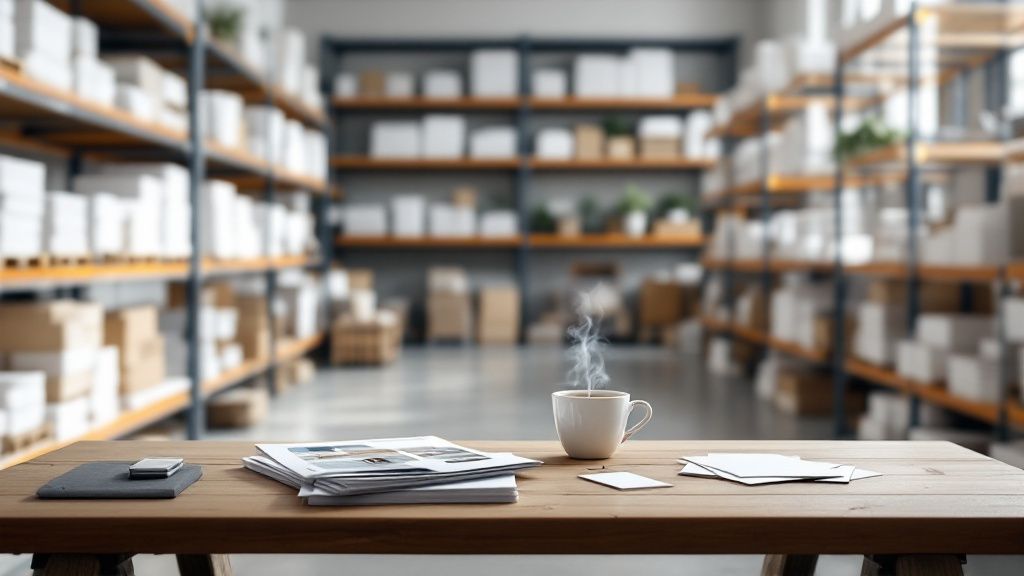
Trying to pin down a single price for printing at Warehouse Stationery is a bit like asking, "How much does a bag of groceries cost?" The answer is always: it depends on what you put in your trolley. A handful of simple A4 copies might only set you back a few dollars, while a large-scale project with all the trimmings could run into the hundreds.
The final price tag really comes down to the choices you make. Key ingredients like the paper quality, the amount of colour ink used, and, of course, the quantity you need all play a part.
Understanding Warehouse Stationery Printing Prices
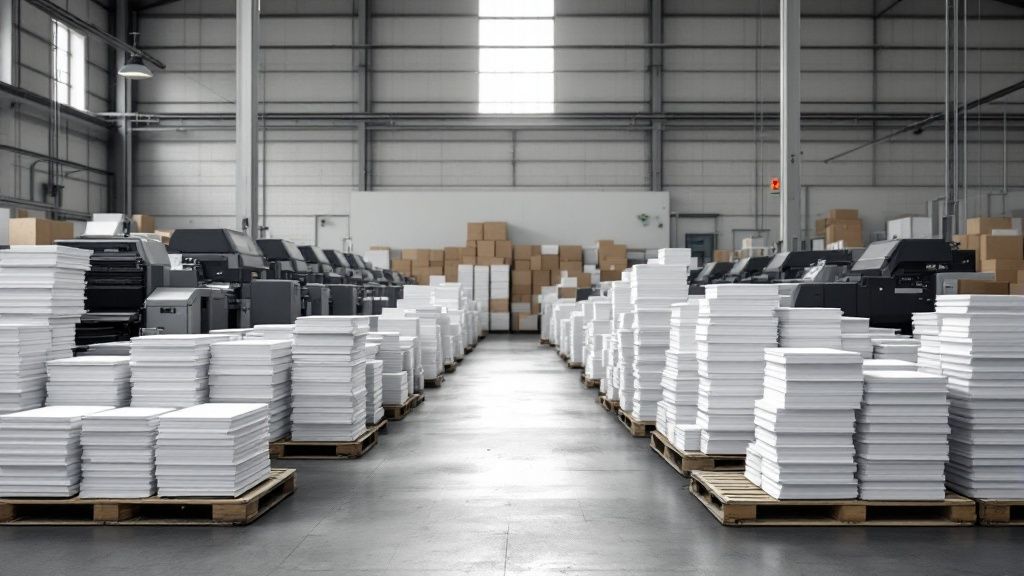
Breaking down the costs is easier than you might think. A good analogy is ordering a pizza. A basic margherita has a set price, but as you start adding extra toppings—pepperoni, mushrooms, anchovies—the total creeps up. Each addition changes the final bill.
Printing works on the exact same principle. Your quote isn't a random number; it's a sum of all the parts you've chosen for your project. Let's walk through what those parts are and how they affect your budget.
Key Factors That Build Your Quote
The main components that come together to determine your final printing cost are:
- Paper Choice: Are you after standard 80gsm copy paper or something more substantial, like a thick 350gsm cardstock for business cards? The heavier and more premium the stock, the higher the cost.
- Ink and Colour: A straightforward black-and-white document is always the most budget-friendly option. As soon as you introduce full-colour graphics or photos, the price will naturally increase.
- Order Quantity: This is where you can see real savings. Thanks to economies of scale, the price per item almost always drops as your order volume goes up. Printing 500 flyers will be much cheaper per unit than printing just 50.
- Turnaround Time: Need it yesterday? Express or same-day services are available, but they come with a premium for the rush job. If you can wait, standard delivery is the most cost-effective route.
Getting your head around these variables is the key. Once you understand them, you can budget confidently for anything from event posters to professional reports, knowing exactly what you’re paying for.
This knowledge gives you the power to tweak your project to fit your budget without having to compromise on the final product. For instance, if money is tight, you could opt for a slightly lighter paper stock or simply plan ahead to avoid those last-minute rush fees. It’s all about making informed decisions.
The Core Factors That Shape Your Printing Costs
When you get a quote back from a printer, every dollar is tied to a specific decision you've made. Getting your head around these choices is the secret to keeping your budget in check. Think of it like a chef picking ingredients; your printer is combining materials, inks, and processes to cook up your final product, and each element has its own price tag.
By breaking down the five key pillars of print pricing, you'll see exactly where your money goes. This kind of clarity helps you spot where you can save a few dollars and where you absolutely need to invest to get the result you want.
This visual gives you a great overview of the main things that will influence the final cost of your print job.
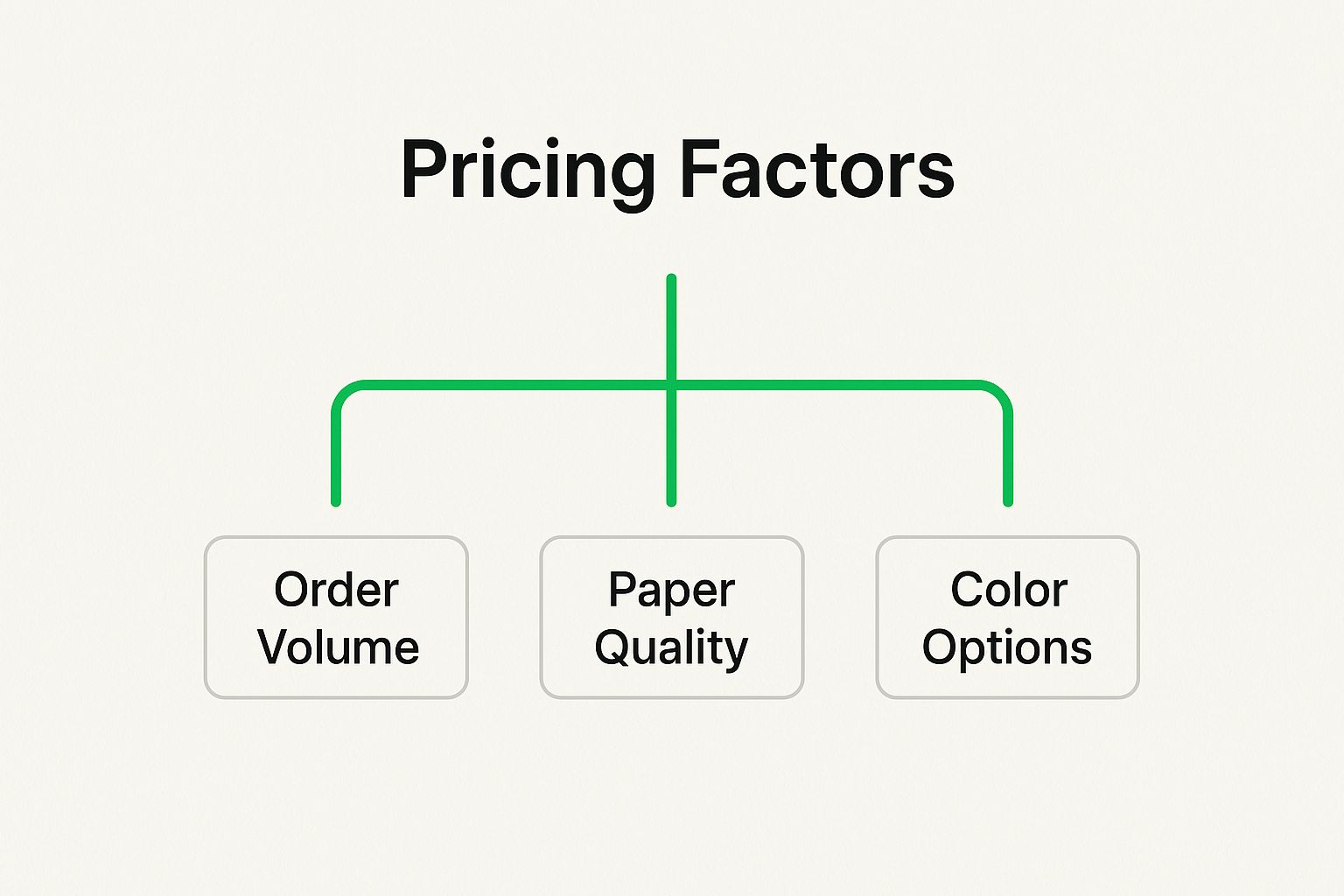
As you can see, the size of your order, the paper you choose, and your colour selections are the real heavy hitters when it comes to your printing expenses.
Material Choice and Ink Complexity
The first big decision is your paper stock. This is the foundation of your whole project. A lightweight 80gsm paper is great for everyday internal memos, but a sturdy 350gsm cardstock is what gives a business card that premium, durable feel. The heavier and more specialised the paper—like glossy, matte, or recycled options—the more it’s going to cost.
Next up is ink complexity. Printing in simple black and white is always the cheapest route. Once you jump to full colour, the process gets more involved, requiring four different inks (cyan, magenta, yellow, and black) to create the spectrum. Naturally, this bumps up the price. The more of the page your design covers with ink, the more it will cost, too.
Volume and Finishing Touches
Order volume is where you can really make some smart savings. The initial setup cost for any print run is a fixed expense, whether you’re printing 50 flyers or 5,000. Because of this, the price per item drops dramatically the more you order. Printing in bulk is easily one of the most effective ways to slash your per-unit cost.
Finally, you have the finishing touches—those little extras that make your project look polished and professional. These are things like:
- Laminating: Adds a protective layer with a gloss or matte finish.
- Binding: Essential for reports and booklets (think spiral, comb, or perfect binding).
- Folding: For creating brochures or multi-panel flyers.
- Custom Cutting: For unique shapes that break away from the standard rectangle.
Each of these services adds extra labour and material costs, so it’s worth thinking about which ones are truly essential. When you're weighing up costs, remember that customisation options, like those available for personalized pens, also play a big part in the final price.
The Urgency Factor: Deadlines
The last variable is your deadline. A standard turnaround time lets the printer schedule your job efficiently, which keeps their costs—and yours—down. But if you need something done yesterday, you’ll have to pay for an express service. That rush fee covers the extra shuffling and overtime needed to bump your job to the front of the queue. A little bit of forward planning is a simple but powerful way to avoid this extra charge.
To help you visualise how these choices stack up, here’s a quick breakdown.
Printing Cost Factor Impact Analysis
This table shows how different choices can swing your budget from low to high, helping you decide where to spend and where to save.
| Cost Factor | Low-Cost Option | High-Cost Option | Impact on Price |
|---|---|---|---|
| Paper Stock | Standard 80gsm uncoated | Heavy 350gsm+ specialty cardstock (e.g., textured, recycled) | High |
| Ink Complexity | Black & white only | Full-colour (CMYK) with heavy ink coverage | High |
| Order Volume | Small run (e.g., 50 units) | Large bulk run (e.g., 5,000+ units) | Very High (per unit) |
| Finishing | None (trim to size only) | Multiple finishes (e.g., laminating, foiling, custom die-cutting) | Medium-High |
| Deadline | Standard turnaround (5-7 business days) | Urgent express service (same-day or 24-hour) | Medium |
As you can see, paper, ink, and volume have the most significant impact, while finishing and deadlines are more moderate factors you can adjust based on your project's specific needs.
A Practical Guide to Printing Price Ranges
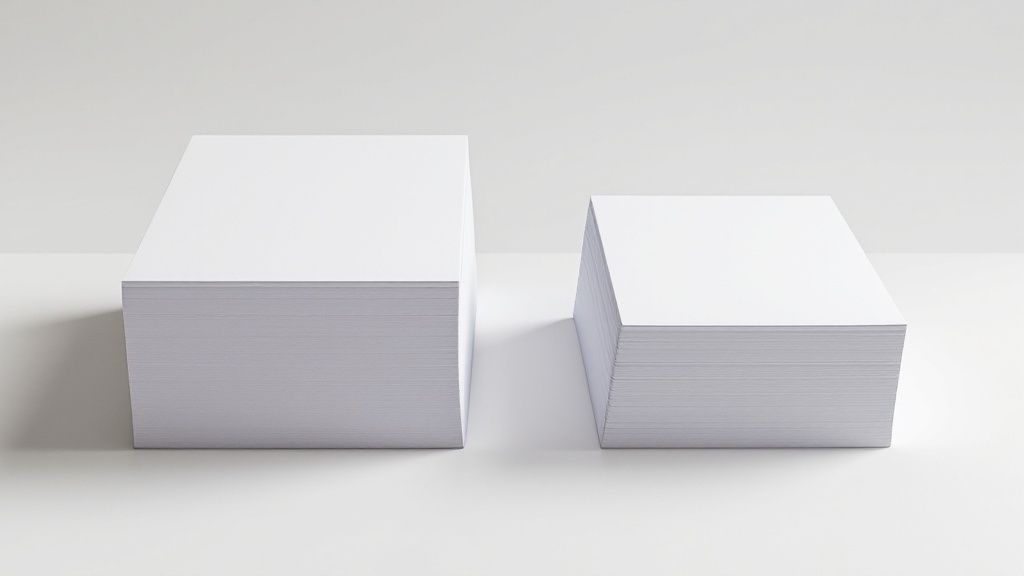
To make budgeting a bit less of a headache, it helps to have a rough idea of what common print jobs actually cost. Warehouse stationery printing prices aren't a big secret; they follow predictable patterns based on what you're printing, the materials you choose, and how many you need. Getting a handle on these ballpark figures lets you plan your spending and avoid that sticker shock when the final invoice lands in your inbox.
This guide breaks down realistic price ranges for some of the most popular business printing needs here in New Zealand. By looking at real examples, you can start building a financial picture for your next project, whether it’s for a marketing push, day-to-day operations, or internal comms.
Business Cards
Business cards are a classic networking tool, but their cost can swing wildly depending on the impression you’re trying to make. They're the perfect example of how small decisions about paper and finish can really add up.
- Entry-Level: For a simple, no-fuss option, you're looking at around $40 to $70 for a stack of 250 standard cards on a decent 300gsm matte stock. This is a great starting point for new businesses or for when you need to hand them out like confetti.
- Premium Finish: Want something that feels a bit more special? Upgrading to a heavier 400gsm stock with a gloss or matte laminate could set you back between $90 and $150 for the same number of cards.
Flyers and Brochures
Flyers are brilliant for getting the word out, and their price is super sensitive to size and paper weight. A standard A5 flyer is usually the most cost-effective choice for big campaigns.
For example, printing 500 single-sided A5 flyers in full colour on a lightweight 150gsm gloss paper generally falls into the $120 to $180 range. Of course, if you decide to print on both sides or go for a folded A4 brochure, the price will climb to account for the extra ink and finishing work.
Just remember that these prices can shift. The cost of paper and ink is tied to global supply chains, and those fluctuations eventually find their way into local warehouse stationery printing prices. This makes planning ahead and ordering in bulk more important than ever.
This is particularly true right now. New Zealand’s stationery market is part of a global industry expected to grow from USD 147.56 billion in 2024 to USD 225.99 billion by 2033. That growth points to rising demand, which could put pressure on the price of print materials down the line. It's worth exploring more about these global market trends to see how they might affect your costs in the future.
Posters and Large Format Prints
When you really need to grab someone's attention from across the room, you can't beat a poster. The price here is driven almost entirely by two things: size and the material it's printed on.
- A2 Posters: A small run of five A2 posters on a standard 200gsm satin paper will probably cost you somewhere around $50 to $80.
- A0 Posters: For maximum impact, a single huge A0 poster could be anywhere from $40 to $60, depending on the paper you choose.
Bound Documents and Reports
For those professional presentations or crucial company reports, proper binding is a must. The final cost comes down to the number of pages and the style of binding you go with.
A 50-page, full-colour report printed on standard paper with a simple spiral or comb bind might cost between $25 and $40 per copy. The good news is the price per unit usually drops the more copies you print at once.
How Technology Is Changing Printing Costs
The world of printing is evolving, and these changes are having a real, positive impact on your wallet. Technology isn't just about making printers faster; it's making the entire process smarter and more tuned-in to what businesses actually need today. The bottom line for you is more flexibility and better value.
Two big shifts are driving this change: Print on Demand (POD) and workflow automation. These two are rewriting the old rules, shifting the industry away from the classic "buy-in-bulk" model to something far more agile and cost-effective. Getting your head around them will help you make much smarter decisions with your printing budget.
The Rise of Print on Demand
Think of old-school printing like doing a massive shop at a bulk-buy store. You had to commit to a huge quantity to get a reasonable price per item, even if you only needed a handful. This usually meant paying for hundreds of brochures that ended up collecting dust in a back room.
Print on Demand turns that whole idea upside down. It’s more like the Netflix of printing—you get exactly what you want, right when you need it. Whether you need ten bespoke flyers for a small trade show or a single personalised poster, POD technology finally makes small print runs affordable.
This is a massive win for small businesses, in particular. It gets rid of the need for big upfront cash outlays and completely removes the risk of getting stuck with a pile of outdated stock. You can trial new marketing concepts with small batches or create highly customised stationery without being locked into a huge, expensive order.
Print on Demand (POD) and automation are becoming crucial trends in New Zealand's printing scene, directly affecting warehouse stationery printing prices by improving efficiency and slashing waste.
As Kiwi businesses hunt for smarter ways to manage costs, POD is the perfect fit. It produces items in exact quantities, which means no more dead inventory or paying for storage. This shift is also being driven by rising labour costs and staff shortages, pushing print shops to invest in automated systems that need fewer hands on deck and can deliver jobs much faster. You can read more about these NZ printing industry trends and see how they're shaping the future.
How Workflow Automation Reduces Costs
Beyond the printing press itself, technology is also smoothing out the entire journey from design to delivery. Workflow automation takes care of all the fiddly, time-consuming tasks that used to be done by hand, and those efficiencies get passed on to you as savings.
Here’s a breakdown of how it helps lower your costs:
- Faster File Processing: Smart software can instantly scan your uploaded files for common problems, like low-resolution images or incorrect dimensions. This catches costly mistakes before anything goes to print.
- Reduced Labour: When job scheduling, proofing, and even dispatch are automated, printers can run with leaner teams. This keeps their overheads down, which helps keep your prices competitive.
- Quicker Turnaround: An automated system means your job flows seamlessly from one step to the next without hitting any bottlenecks, getting your finished stationery in your hands much sooner.
At the end of the day, these tech upgrades allow printers to do better work, more efficiently. That powerful mix of on-demand flexibility and automated speed leads directly to better warehouse stationery printing prices and a much less stressful experience for you.
Smart Ways to Lower Your Printing Bills
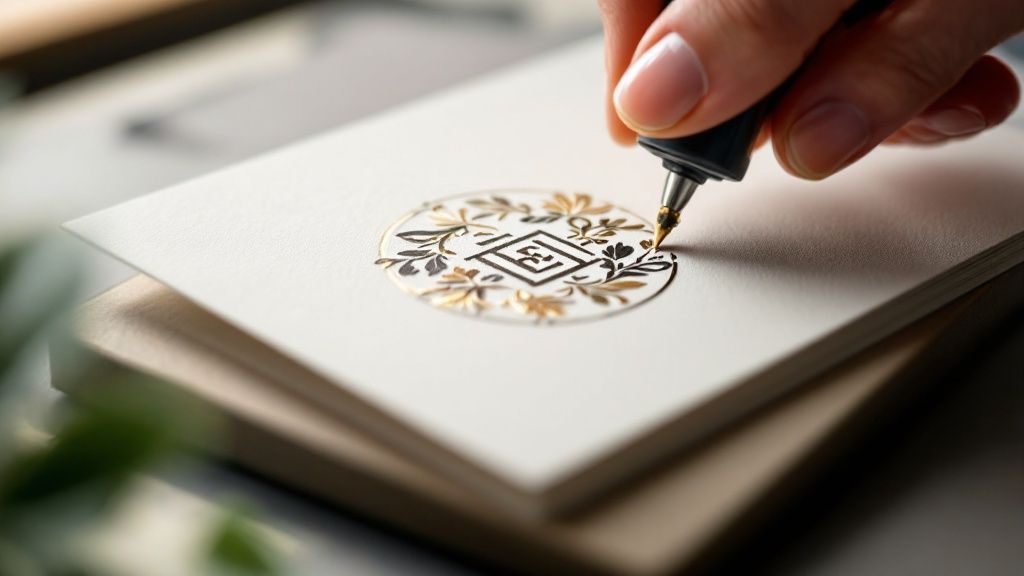
Knowing what drives printing costs is the first step, but the real magic happens when you use that knowledge to actively cut your expenses. You don't need to sacrifice quality to make your budget work harder. A few smart tweaks to how you plan and place your orders can make a huge difference.
These aren't industry secrets, just practical, common-sense approaches that add up to big savings over time.
Think of it like doing a grocery shop. If you go to the supermarket every day for one or two items, you spend more time and probably more money on impulse buys. But if you plan your meals for the week and do one big shop, you’re far more efficient and your budget stays intact. The same logic applies to printing.
Plan Ahead to Dodge Rush Fees
The easiest win? Give yourself plenty of time. Last-minute jobs nearly always get hit with rush fees to jump the production queue. By simply planning your printing needs a week or two ahead, you can cruise along with standard turnaround times and avoid those extra costs entirely. A little forward-thinking is your best defence against unnecessary spending.
Bundle Your Print Jobs Together
Every time a printer starts a new job, there are fixed setup costs involved. Think of it as the price of admission. When you bundle multiple jobs—say, your business cards, flyers, and letterheads—you only pay that "admission fee" once. This creates an economy ofscale that directly lowers your total bill. It’s a much smarter move than placing three small, separate orders throughout the month.
The single biggest, and most preventable, expense in printing is the reprint. A simple typo or an incorrect phone number can render an entire batch of flyers useless, forcing you to pay for the whole job twice.
Meticulous proofreading isn't just a good habit; it's a critical cost-saving measure. Before you ever hit 'send' on a file, get a fresh pair of eyes—or better yet, two—to check it for any mistakes. This one simple step can save you hundreds of dollars and a whole lot of headaches.
Stick to Standard Sizes
Custom-sized stationery can certainly stand out, but it often comes at a premium due to wasted paper. Printers work with massive "parent sheets," and standard sizes like A4, A5, and DL are designed to fit perfectly onto them with minimal offcuts. When you stick to these common dimensions, the process is more efficient for the printer, and those savings get passed straight on to you.
Actionable Checklist for Reducing Print Costs
To pull it all together, here's a quick checklist you can run through before every order. Following these simple steps will help you lock in the best possible warehouse stationery printing prices every single time.
| Strategy | Description | Potential Saving |
|---|---|---|
| Proofread Everything | Have multiple people check your files for typos, incorrect dates, or low-resolution images before submitting. | Very High |
| Order in Bulk | Increase your order quantity to significantly lower the cost per individual item. | High |
| Choose Standard Sizes | Stick to common paper sizes like A4 and A5 to reduce material waste and production complexity. | Medium |
| Plan in Advance | Avoid express service charges by ordering with enough time for a standard turnaround. | Medium |
| Bundle Different Jobs | Place orders for multiple items (e.g., cards and flyers) at the same time to minimise setup fees. | Medium-High |
These strategies are all about working smarter, not harder. By building these habits into your ordering process, you can consistently control your costs without ever compromising on the professional look of your printed materials.
Got a Few More Questions About Printing Prices?
Even after breaking down all the costs, there are always a few lingering questions that pop up right when you're about to hit 'order'. It’s completely normal. Getting these details ironed out is the key to feeling confident about your budget and avoiding any last-minute surprises.
So, let's tackle some of the most common queries we hear about Warehouse Stationery printing prices.
Is It Cheaper to Print In-Store or Online?
Ah, the classic dilemma. The honest answer is: it really depends on what you’re printing.
If you just need a few A4 pages printed quickly, popping into a store is probably your best bet. It's fast, straightforward, and you can have your documents in hand within minutes. For those small, urgent jobs, the convenience is hard to beat.
But when you're thinking bigger—say, a run of several hundred business cards or a stack of multi-page brochures—the online portal is almost always where you'll find better value. The online system is set up for larger volumes, and its automated process often translates into savings that get passed on to you. Plus, you get to play around with all the options and see the price change in real-time, which is a huge help for budgeting.
How Much Extra Does Double-Sided Printing Cost?
Printing on both sides of the paper (often called duplex printing) is a brilliant way to be more eco-friendly and create a more professional-looking document. It does cost a little more than single-sided printing, but it definitely won't double the price.
That slight price bump covers the extra ink and the more technical machine setup required to get the alignment perfect on the second side. For most projects, it's a small price to pay for the polished result.
Think about it from the reader's perspective. A double-sided flyer or report feels more complete and less flimsy than two separate pages. It’s a subtle touch that can make your brand feel more substantial.
Ultimately, that user experience matters. A handout that feels thoughtfully put together leaves a much better impression than one that seems cheap or wasteful.
What's the Absolute Cheapest Way to Print Flyers?
If your goal is maximum reach on a shoestring budget, there's a tried-and-true formula for getting the most bang for your buck. To get the best possible warehouse stationery printing prices on flyers, here's what you need to ask for:
- Size: Go with A5. It's a standard, efficient size that printers can produce with minimal waste.
- Paper: Ask for 150gsm gloss. This paper weight is the industry go-to for a reason—it feels professional enough without the premium price tag.
- Quantity: Order more than you think you need. The cost-per-flyer drops dramatically with larger orders, so aim for 500 or more if you can.
- Sides: Stick to single-sided printing. This cuts down on both ink usage and machine time.
This combination is the sweet spot, giving you a flyer that looks great without costing a fortune.
Which File Format Should I Use for the Best Quality?
Hands down, PDF (Portable Document Format) is the king of print. When you save your design as a high-resolution PDF, it locks everything in place—your fonts, your images, your layout, everything.
This means you can be confident that what you see on your screen is exactly what will come out of the printer. No more nasty surprises like wonky text or blurry logos. While a JPG or PNG might be fine for a simple photo, a PDF is the only way to go for designs that mix text and images to guarantee a crisp, professional finish.
At SONI DESIGN, we’re all about bringing your ideas to life on paper. From standout signage to beautifully crafted business cards, we pour our passion and expertise into every project. Let's work together to create something that truly captures your vision! https://www.sonidesign.co.nz
Leave a Comment
Stay home & get your daily
needs from our shop
Start You'r Daily Shopping with Nest Mart
Best prices & offers
Orders $50 or more
Free delivery
24/7 amazing services
Great daily deal
When you sign up
Wide assortment
Mega Discounts
Easy returns
Within 30 days
